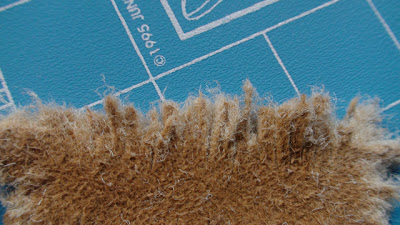 |
| Mink, George Catlin, showing fuzzy fringe edge at neckline and on edges of hide |
 |
| Arikara Dress showing patches of fur along bottom edge as well as softened fringe |
Take a close look at the edges of the hides used for the Two Hide dress, especially in the Arikara dress. (You can click on the picture and then zoom in on it further, I purposely left it larger to show detail).
 |
| Long fringe, twisted fringe and short fringe feathered sharp cut edge on far right |
You will note that there seems to be a fringe of fur all around the edge. Well at least in some places. The hide around the fold over flap purposely has the hair left on, as well as the tail being left on as a focal point. But the edge of the entire dress is softened somehow, without being sharply fringed.
George Catlin's paintings also illustrate the fuzzy edge in places, (like the neckline), that would be cut out of the inner and not on the edge of the hide. Where did the fuzz come from? Couldn't Catlin paint fringe? I think he could. His paintings are so detailed you can see the individual beads and porcupine quills.
So what's going on here? I think they deliberately frayed the edges. It would soften the look and make the edges more pliable and improve the drape.
 |
| Close up, sorry about focus entire edge of fringe and cut edge brushed |
 |
| Sharp cut edge on left, rest feathered. |
On that line of thought, I took a scrap piece of my brain tan and made some experiments.
I cut long fringe, long twisted fringe and short fringe. I then took a wire brush and lightly teased the edges. These pictures are my results.
I got a bit carried away, but as you can see, the brushing greatly improved the softness of the edge of the hide, note the hard sharp cut edge to the far right of the first picture and the left edge of the bottom picture.
Did they use wire brushes? Probably not. Wire making was in its infancy at this time and was very expensive.
Did they have a tool that could create the same result? Thinking of porcupine brushes and other stiff bristled objects they had, maybe so.
The best looking fuzzy edge was made by making 1/4 inch cuts to the flesh side of the leather with my rotary cutter, (yes, I am aware they did not have one of those either, but so be it), Then I lightly teased the flesh side, flipped it over and teased the front. The results are the center(second) picture, look on the top edge of the hide in the center of the picture, slightly to the right. It gave a fine result, and the leather became oh so much more pliable.
Further testing has supplied the following results:
Further testing has supplied the following results:
 |
| 1/4 inch fringe cut from flesh side on top 1/2 inch fringe on bottom |
 |
| I then scrunched it, twisted it, balled it up to see what wear would do |
 |
| 1/4 inch fringe on a curve, also roughed up afterwards |
If you are interested in the process and have an opinion or suggestion, I would sure like to hear from you on this. Please leave a comment, I value your input.
A note aside, if you try this method, fluff outside. It creates a tremendous amount of fuzz in the air and on clothing.
Very interesting work. Congratulations and thank your for sharing your blog. I will visit our page again.
ReplyDelete